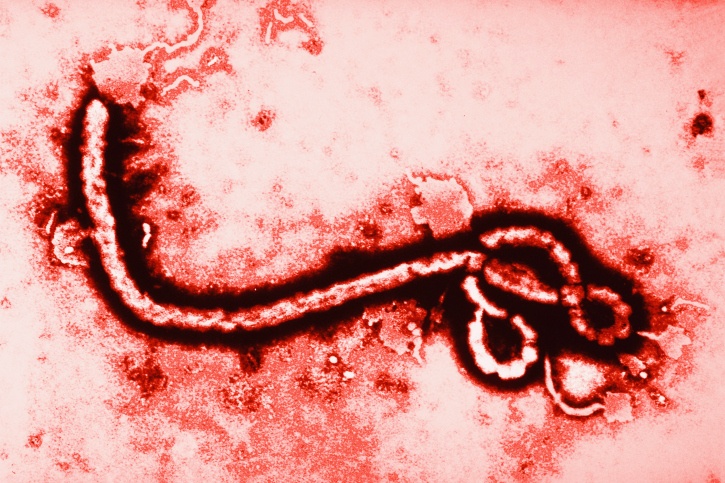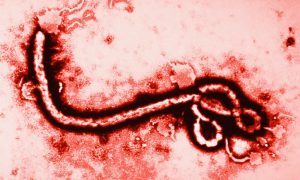“This post contains affiliate links, and I will be compensated if you make a purchase after clicking on my links.”

Last week, in the wake of the first confirmed case of Ebola to reach the United States, we published a study by the CDC that was conducted in 2001 during the Ebola outbreak in Gabon that looked at Ebola and dogs. In that study and subsequent article, entitled “Ebola Virus Antibody Prevalence in Dogs and Human Risk”, The CDC observed dogs that were highly exposed to Ebola virus by eating infected dead animals. To examine whether the dogs became infected with Ebola virus, they sampled 439 dogs from epidemic areas in Africa and a control area in France and screened them for the virus. Not surprisingly, many of the dogs from the virus-epidemic area screened positive for Ebola.
In the report, they noted that the dogs – though positive for the Ebola virus and antibodies – did not exhibit any symptoms of Ebola, did not get sick from the virus, and did not die.
However, in the report, the CDC did make the conclusion that dogs spreading Ebola to their human companions was, in fact, a possibility.
Although dogs can be asymptomatically infected, they may excrete infectious viral particles in urine, feces, and saliva for a short period before virus clearance, as observed experimentally in other animals. Given the frequency of contact between humans and domestic dogs, canine Ebola infection must be considered as a potential risk factor for human infection and virus spread. Human infection could occur through licking, biting, or grooming.
They went further to describe numerous occasions when they believed this to have occurred:
Dogs might also be a source of human Ebola outbreaks, such as the 1976 Yambuku outbreaks in Democratic Republic of Congo (19), the 1995 Kikwit outbreak, some outbreaks that occurred in 1996 and 2004 in Gabon and Republic of Congo (5), and the 1976 (6), 1979 (20), and 2004 (21) outbreaks in Sudan, the sources of which are still unknown. Together, these findings strongly suggest that dogs should be taken into consideration during the management of human Ebola outbreaks.
Now – On October 13th – the CDC published a series of Questions and Answers about Ebola and Pets on their website. The information they provided in that statement is vastly different from what was published in their earlier study and report. We’re left wondering…which one is the truth? Let’s take a closer look at the CDC’s latest position.
Can Dogs Get Infected or Sick with Ebola? The CDC now says:
At this time, there have been no reports of dogs or cats becoming sick with Ebola or of being able to spread Ebola to people or other animals. Even in areas in Africa where Ebola is present, there have been no reports of dogs and cats becoming sick with Ebola. There is limited evidence that dogs become infected with Ebola virus, but there is no evidence that they develop disease.
Limited evidence that dogs can become infected with the Ebola virus? This contradicts what they reported in their 2002 study! To quote the opening paragraph of the study:
Among dogs from villages with both infected animal carcasses and human cases, seroprevalence was 31.8%. A significant positive direct association existed between seroprevalence and the distances to the Ebola virus–epidemic area. This study suggests that dogs can be infected by Ebola virus[…]
Has the CDC changed their mind, is there new evidence that refutes their old study, or are they lying to us? Some have suggested they are backpedaling in the wake of the Spanish government euthanizing Excalibur, the canine companion of a nurse in Spain who contracted the Ebola virus.
And if there’s no evidence of dogs spreading Ebola, why is Bentley – the Dallas nurse’s Cavalier King Charles Spaniel – in quarantine and being cared for by people in Hazmat suits? We also can’t help but wonder – why don’t they test Bentley for the virus, like they tested those 439 dogs for the study in 2002?
Also in the CDC’s 2002 study, they reported that once the virus is cleared from the dog it is no longer contagious to humans:
…they may excrete infectious viral particles in urine, feces, and saliva for a short period before virus clearance…
We contacted the CDC to find out specifically how long it takes for a dog to clear the Ebola virus and no longer be contagious to humans, but so far we’ve not been able to get more than a form-letter response about how Ebola is spread.
The CDC is just leaving us with more questions than answers.


















